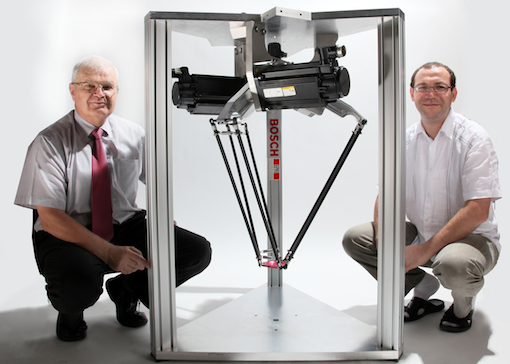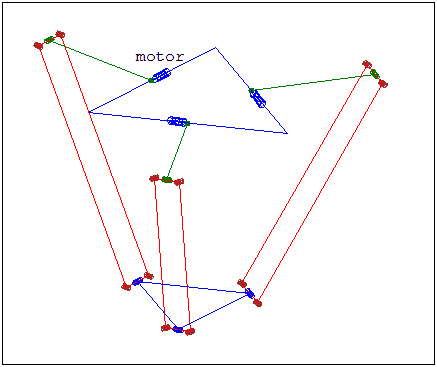Kinematics of a Delta Robot in CGA
Delta Robots
- Very fast moving
- Simple forward and inverse kinematics
- Cheap and easy to build
History of the Delta Robot

- Invented by Reymond Clavel at EPFL in 1985
- A type of parallel manipulator
Model of a Delta Robot


Forward Kinematics
Reachable Volume
Inverse Kinematics
If \(T_i^2 < 0\) then the point is unreachable
Forward Jacobian
- Move only one motor
- This fixes two of the spheres, they intersect in a circle
- We are therefore interested in the differential of the end point of the point pair made from intersection of the circle and the moving sphere
- First we need to find how the center of the sphere changes as we move theta
- How does point pair move with the sphere?
Forward Jacobian (2)
- Now we need to know how the conformal endpoint of the point pair changes
- How does the 3D endpoint change with the conformal endpoint change? (derivative of 'down' function)
Forward Jacobian (3)
- We now have a closed form expression for the derivative of the endpoint wrt. theta and we didn't have to use maple once!
- We can use this for control and optimisation. Consider a cost function:
Forward Jacobian In Use
- We therefore have a closed form for
and so can do gradient descent
- Given the forward jacobian we can simply invert the 3x3 matrix at each point to get the inverse jacobian
OR
- We can differentiate our inverse kinematic equations..
Inverse Jacobian
Starting with Sigma_i
Differentiate wrt. a scalar param \alpha
the sphere centred at the meeting of the 4 bar mechanism and the end platform
- Now we need to know how the elbow positions vary with \alpha
Inverse Jacobian (2)
- Here A_i is the conformal elbow position
- Finally we need to know how the joints vary with elbow position
Inverse Jacobian (3)
- We are done (Once again no Maple!)
- The inverse jacobian allows us to map velocity of the endpoint to velocity of joints
Inverse Jacobian in Use
- In other words, to minimise cost at maximum rate drive the end point linearly at our target point (obviously)
- With the inverse jacobian we can do exactly that
- CGA provides a very neat framework for solving the forward and inverse kinematics of parallel robots
- We can easily simulate the dynamics of the robot with clifford and ganja.js
Summary


- Trivectors in CGA represent lines and circles
- The direct interpolation of lines and circles results in trivectors interpretable as general screws
- Screw theory is widely used in robotics for analysis of kinematics and dynamics
- Lets bring screw theory and CGA (also PGA) together properly and analyse a whole load of systems